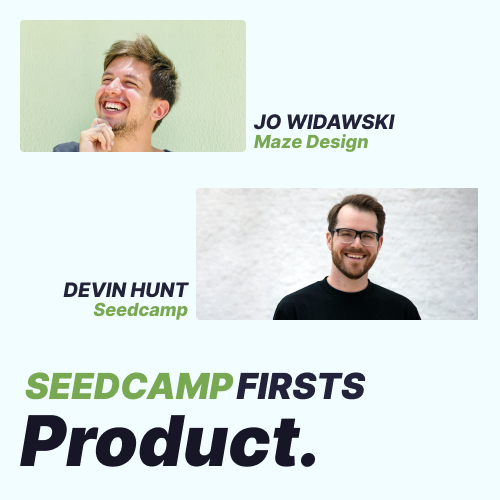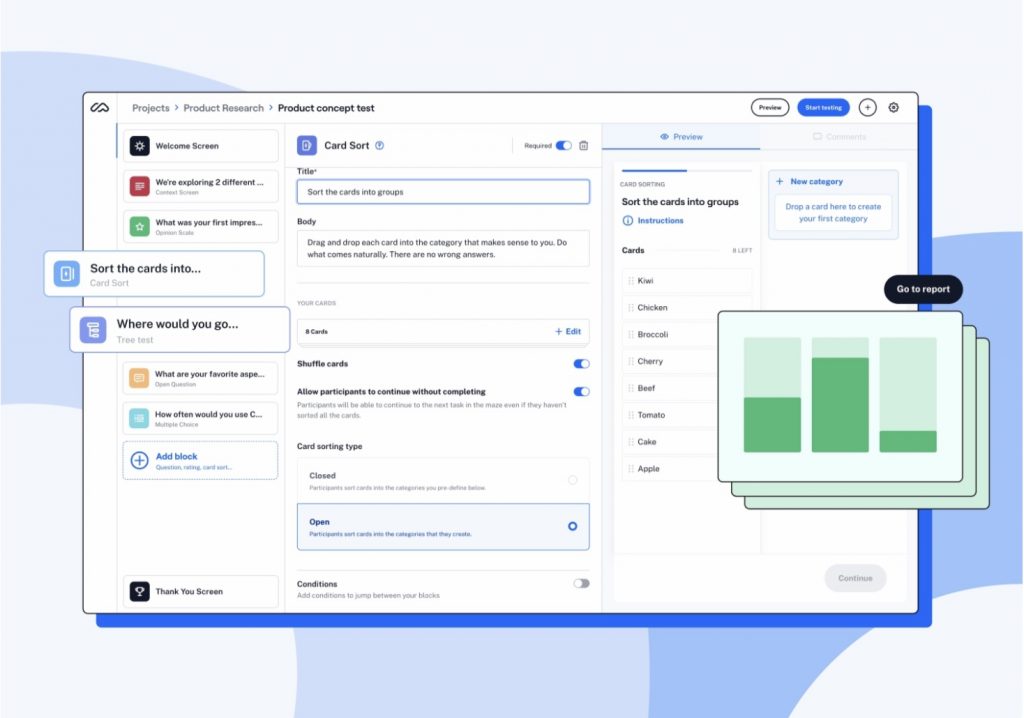An interview with Jonathan Widawski, Co-founder and CEO of Maze, and Devin Hunt, Venture Partner at Seedcamp.
We’re excited to introduce Seedcamp Firsts, the definitive guide to the all-important first steps in company building brought to you through first-hand experiences and lessons learned from the brightest minds across the Seedcamp Nation.
The power of the Seedcamp Nation comes from the incredible breadth of experience that’s been lived across it. We want to open up this hard-won knowledge and insights from the exceptional founders we’ve backed to our mentors, Experts in Residence, Venture partners, and our core team. Our ultimate goal with Seedcamp Firsts is to help support the next generation of exceptional entrepreneurs navigate those critical first steps in building a business.
We’re thrilled to kick off our Seedcamp Firsts series with Jonathan Widawski, co-founder and CEO of Maze, a Seedcamp-backed growth-stage company on a mission to democratize product research. In this piece, we will explore everything from prioritising what to build, and when, to how to evaluate customer input in product development decisions.

The founding story of Maze
While building their previous startup, a messaging app for gamers called Ping, Jonathan, and his co-founder Thomas Mary, stumbled upon a ground-breaking idea. In Jonathan’s own words:
“The reality was we didn’t have a product yet. What we had at the time was this very in-depth InVision prototype of what we wanted to create. And so we thought, how do we get insights in our value proposition, which flows are working, which design is performing better, before actually having to build a thing and not having to interview 12,000 people.” – Jonathan Widawski
They hacked together a solution by adding an analytics layer to an InVision prototype. This would become the prototype for Maze.
Their instant revelation: “We could collect quantitative data that we would be able to collect post-development at a pre-development stage.” Discovering a treasure flow of available data made them realize that using this method would enable them to iterate without having to spend money on building.
“What we did at the time was we built the first version in a couple of months. It was really basic. It was bare bone. We were manually creating the heat maps, like all of these things that it had no bells and whistles.” – Jonathan Widawski
Jonathan returned to his job as a lead UX designer and convinced his clients to test their prototypes with the Maze tool. Even though they were generally reluctant to do customer research, they accepted, giving the Maze team access to some of their customers. Finding great value in the results of the prototype tests, the clients provided Jonathan and Thomas with proof that they were on the right track with what they were building.
“Especially when you are successful in selling a process that you’ve been unsuccessful selling for this type of customers for years, and especially when they automatically attach it to a return on investment, when they can attach a budget value to it, to me it was a great sign that yes, the stars are aligning. There is a product that we built that is bringing value that we can then attach to a budget within the organization. And all of this means that if we can replicate this a hundred thousand times, we have an actual business. This is the type of signal that you’re looking for.” – Jonathan Widawski
Jonathan and Thomas started building Maze in 2018 to democratize product research everywhere. Their initial goal was to make research – traditionally limited to the largest enterprises – happen everywhere, in companies of all sizes, including startups, and in all industries.
Their vision evolved into enabling research to transcend the researchers’ role, becoming a tool that the whole organization would use. The founders applied this principle in building Maze, ensuring everyone was involved in the research journey.

Tune in and/or read on to learn more about the founding story of Maze and discover Jonathan’s top insights on how to test, explore and validate your first product ideas as an early-stage startup:
[Listen on your favourite podcast platform here.]
Q & A with Devin and Jonathan:
Devin: How did you choose what to build?
Jonathan: The fun part of the story is that while (…) we experienced the pain firsthand, Maze actually got started in the previous startup that we launched with my co-founder Thomas. It has nothing to do with what we’re doing today. We were building a messaging app for gamers, Ping, as it was called at the time.
And the reality was we didn’t have a product yet. What we had at the time was this very in-depth InVision prototype of what we wanted to create. And so we thought, how do we get insights in our value proposition, in which flows are working, in which design is performing better, before actually having to build a thing, and not having to actually interview 12,000 people. So, what we did at the time is we hacked our way into building what would become Maze, later on, which is, we downloaded our InVision prototype. And we started putting analytics on top of everything with the idea that if we’re able to aggregate the data on the prototype and make sense of that data, we wouldn’t have to run all of these interviews.
We could collect quantitative data that we would be able to collect post-development at a pre-development stage. We pushed this Maze “V0” to 2000 people. And one hour later, we got thousands of responses. I come from a world where five responses in five weeks was basically opening champagne, and all of a sudden, we had this treasure flow of data available to us.
It was completely mind-blowing, seeing a) the data was available, but b) also that all of a sudden, the cost of iteration, didn’t include the cost of development. That all of a sudden, we had the means to iterate at a stage where we didn’t have to spend money on building something. And so that’s the long story short on the previous startup that obviously didn’t work, but it felt obvious at the time that we found something at least that we found extremely valuable and that we started Maze.
Devin: As you started to build, obviously, there were lots of micro decisions to make around the right way to prioritize and what to do next. And I know, at least when we were working together closely, InVision is where you started.
Jonathan: Especially in the early days, it feels like you want to build everything, but you really have the resources to build one thing. So, you have to basically nail down all of this discussion. And I think that it all boils down to a very simple question, which is almost what is the real thing that’s going to 10x the business in the next year to come. And so it might sound silly in the end, but the reality for us was always what is the marginal incremental change that we can make and what is the thing that’s really going to unlock for us the next stage of the mission and the vision that we’re trying to build?
Devin: One of those challenges young companies face is they have a customer in mind or maybe one or two references, but that’s a very small data set when trying to validate some big decisions. Are there any specific formulations you’ve baked into Maze since then to build that confidence or make it more objective than subjective?
Jonathan: At the 10-people team (stage), what I felt was the most useful at the time – there’s an analogy that I like to use, which is you shoot the arrow, and then you draw the target around it, which means that at the time you’re going to launch a bunch of experiments, you’re going to test a lot of things, and your vision’s really going to be redefined by what we learn to be successful.
Originally when we started Maze, we started by saying we need a better research tool for researchers, right? That was the vision. We just wanted to build something that was more efficient at the pre-development stage. And all of a sudden, we started seeing designers using the platform, and we started seeing product managers, and we started seeing product markets, and we were like, ‘there’s something there.’
So a lot of it for us was about adapting our strategy to what we were learning on the go, I think very early on, that’s more critical than anything else. It’s just, you’re going to launch things, you’re going to see pockets of things that are successful. So for us, that was things like the new customers that we were starting onboarding on the platform.
We launched a small report, which was just another way to repackage the data that we were doing, that all of a sudden was shared everywhere. So all of these things, you need to take those as signals of almost micro product market fit for some of the features that you have and try to compile all of this into your vision. It’s a very iterative process at this stage of the company.
Devin: How do you decide product market fit or feature customer fit and how do you enable your team to make those decisions independently?
Jonathan: When I talk about product, I like to start with the vision of the company first because I think it’s critical. I think product strategy is not listening to your users. Product strategy is not being a genius product strategy, just turning your company’s vision into something that’s coherent to get you to a vision.
At Maze, we want to live in a world where experiences are shaped by the people who engage with them. So what that really means is that we believe that the future is entirely user-centric and that the companies that will win will be the user-centric companies. Then the mission that we have is how do we get there. We get there by saying we empower anyone to test and learn rapidly.
That’s our mission. We want to empower anyone to test and learn rapidly. What that really means for us is that we give the tools to anyone within the product organization. To be able to run a test and to consume the results of the test to learn and then iterate.
So everything we do at Maze is just getting closer to this mission. So every year at the beginning of the year, we’ll look at the state of where we are. I like to think of the mission as kind of stairs. It’s like, you’re getting closer. You’re climbing those stairs.
Devin: If you were gonna start it all again, how would you start afresh, given all this knowledge?
Jonathan: I think the only thing that I would really do differently is to start from the vision to then build everything else. Because for us at the time, we stumbled upon success, but we didn’t really process success through a vision lens. We built the vision as a successor. The goal is to reach this mission and we can do this by validating things as we grow. Each piece is going to be validated. That changes everything because all of sudden, you sell a coherent story to people that you hire, you sell a coherent story to your investors, you sell a coherent story to people internal to your company. The goal is to reach this mission, and we can do this by validating things as we grow.
This interview has been edited for length and clarity.
Notes:
Jonathan Widawski – twitter.com/WidawskiJ
Devin Hunt – twitter.com/@hailpixel
Maze – maze.com
Seedcamp – seedcamp.com
Further reading:
A New Way to Think About Product-Market Fit